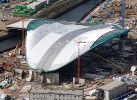
London 2012's 'Big Build' Nearly Done
Construction of venues is ahead of schedule, and the accident rate is below the construction industry norm, according to Stephen Williams, HSE director for the 2012 games.
July 27 is both one year to the day from when the London 2012 Olympics will open and the Olympic Delivery Authority's deadline to complete the "Big Build" of major facilities -- jobs on which 12,000 construction workers have been employed. The ODA and the Health and Safety Executive say the work is ahead of schedule with a low accident rate because HSE has been involved from the outset.
"We are fast approaching the completion of Big Build. HSE has prepared for this challenge and is continuing to capture the good practice found," Stephen Williams, HSE director for London 2012, says on the new website created by HSE with case studies and progress reports.
By July 27, 2011, construction of these new facilities will be finished, according to ODA: Olympic Stadium, Aquatics Centre, Velodrome, International Broadcast Centre/Main Press Centre, handball arena, basketball arena, Lee Valley White Water Centre, all permanent bridges, all utilities, and Stratford Regional Station, a new addition to London's famed transport system.
HSE says its risk profiling approach at the London 2012 sites has worked well. "This project has moved through its range of dynamic changes from enabling, superstructure, fit out, and readiness for use as a world-class sporting venue. We have reviewed the work, considered those new risks that merit our attention, and have once again revised our intervention strategy to take account of Big Build," said Williams. "HSE's construction inspectors have focused on getting assurances that, regardless of the changes on site, the very high safety standards achieved to date are maintained. In particular, we will be looking at how the many new and different contractors on site will be managed, how their competence will be assessed, and how the different phases of fit-out will be coordinated. You will see that we have not gone back to the drawing board. Most of the well-known hazards remain, such as working at height and managing people and traffic movements. They have however changed in nature, with multiple contractors visiting to take on short-term work. It is crucial that this more transient workforce is managed and engaged in the same way as those who have worked since projects began. I welcome the acknowledgement from many key players that complacency is one of the biggest enemies to a project that has a proud safety record to date. Whatever the root cause of the bridge collapse at the Commonwealth Games site in Delhi, we know that 27 construction workers were injured, several of them seriously. It is a stark reminder of the price that can be paid."
ODA Chairman John Armitt said, "Health and safety has always been our number one priority and we are proud of the high standards that have been achieved and maintained by the Olympic Park's workforce to date. This has been done in partnership with all of the main contractors on the site and regulatory bodies such as the HSE."